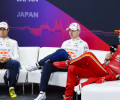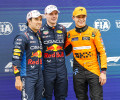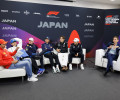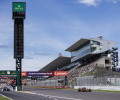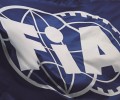Australian Grand Prix - Preview

|
|
|
|
|
Race Preview |
||
|
2014 AUSTRALIAN GRAND PRIX 14-16 MARCH 2014 |
||
|
Formula One returns this week, with Melbourne hosting the Australian Grand Prix, the first round of the 2014 FIA Formula One World Championship. The temporary track around the Albert Park lake provides a stern challenge for drivers and cars alike. As is traditional with street circuits, the surface lacks the grip of a permanent racing facility. This leads to high track evolution as the circuit ‘rubbers-in’ over the weekend making set-up a moving target. The circuit also has various bumps and undulations that have been known to catch drivers out, particularly coming into braking zones, with gravel traps and unyielding walls waiting for the unwary or the unlucky. The 2014 edition of the Australian Grand Prix has another factor to consider. All eyes will be on the performance of F1’s new turbocharged power units. Winter testing suggested the 2014 cars had all the performance of their predecessors but with the hybrid technology still in its infancy, glitches abounded during the three scheduled testing sessions. While teams were able to complete race simulations with increasing confidence towards the end of the testing season, a race of attrition is to be expected in Melbourne. Additionally, teams are still on the learning curve with their new equipment. The new cars will complete the race distance on two-thirds the fuel used by their predecessors – but maximising the potential of that load entails a new paradigm in race craft and is very much a work in progress. Teams have acknowledged this first grand prix of the season will be a voyage into the unknown, with many discovering for the first time the capabilities of their race-specification cars during the practice sessions. It promises to be a surprising and exhilarating weekend. |
 |
|
|
CIRCUIT DATA
|
||
|
|
||
 |
||
|
|
||
|
Australian GP Fast Facts |
||
|
► Albert Park first hosted an F1 World Championship Grand Prix in 1996. It twice held the (Formula Libre) Australian Grand Prix in the 1950s – the 1956 edition being won by Stirling Moss driving a Maserati 250F. ► Of the 18 F1 races held at Albert Park, 11 have been won from the front row. David Coulthard’s victory from 11th in 2003 is the win from furthest back, next is Kimi Räikkönen’s victory last year from seventh on the grid. ► Three drivers make their Formula One debut this weekend. Toro Rosso have Daniil Kvyat (19) driving the STR9. The Russian won the GP3 title in 2013 and Formula Renault 2.0 Alps in 2012. Sweden’s Marcus Ericsson (23) will drive for Caterham. Ericsson is a former champion of Formula BMW UK and Japanese Formula 3. At McLaren Danish driver Kevin Magnussen (21) takes part in his first grand prix. Magnussen is the 2013 World Series by Renault Formula Renault 3.5 Champion and a former champion of Formula Ford Denmark. |
► Returning to Formula One after a season’s absence is Japanese driver Kamui Kobayashi. Now with Caterham, the former Toyota and Sauber man has 60 grand prix starts to his name. He has 28 top 10 finishes with a best result of third, appearing on the podium at the 2012 Japanese Grand Prix. ► 2014 sees many new regulations. In a change to the rules governing tyres, drivers who appear in Q3 will start the race using the tyres with which they set their fastest lap in Q2 – this new rule has been approved by the F1 Commission with a view to ensuring drivers participate in the pole position shoot-out. ► Concerning the race, the essential new sporting regulation introduced for 2014 is a limit on fuel consumption. Between the start of the race and the chequered flag, a maximum of fuel load of 100kg may be consumed – approximately two-thirds of the race consumption of the V8 engines retired at the end of the 2013 season. There is also a maximum fuel-flow rate of 100kg/hour. |
► On the technical side, the new internal combustion component of the F1 power unit is a 1.6-litre 90° V6 unit. It is turbocharged, features direct injection and is limited to 15,000rpm. ► Power will also be provided by two energy recovery systems. ERS-K has a 120kW motor-generator unit (MGU-K), replacing the 60kW unit used previously for KERS. The unit can use 4MJ of energy per lap, up from 400kJ. This specification means 2014 energy recovery will supply twice the power of its predecessor for five times as long. It is sufficient to ensure the MGU-K will be recovering or releasing energy for the majority of every lap at most circuits. ► ERS-K will only be allowed to recover 2MJ per lap. Additional energy will be recovered by a second system, ERS-H, that harvests energy from waste heat in the exhaust. No limit is placed on the amount of energy that can be recovered by ERS-H. |
|
|
||
|
Australian GP Race Stewards Biographies |
||
|
DR GERD ENNSER MEMBER OF THE DMSB’S EXECUTIVE COMMITTEE FOR AUTOMOBILE SPORT, FORMULA ONE AND DTM STEWARD |
 |
|
| Dr Gerd Ennser has successfully combined his formal education in law with his passion for motor racing. While still active as a racing driver he began helping out with the management of his local motor sport club and since 2006 has been a permanent steward at every round of Germany’s DTM championship. Since 2010 he has also been a Formula One steward. Dr Ennser, who has worked as a judge, a prosecutor and in the legal department of an automotive-industry company, has also acted as a member of the steering committee of German motor sport body, the DMSB, since spring 2010, where he is responsible for automobile sport. In addition, Dr Ennser is a board member of the South Bavaria Section of ADAC, Germany’s biggest auto club. | ||
|
|
||
|
TIM MAYER FIA ALTERNATE DELEGATE TO THE USA, FIA STEWARD |
 |
|
| As the son of former McLaren team principal Teddy Mayer, Tim Mayer grew up around motor sport. He organised IndyCar races internationally from 1992-98, aided the construction of several circuits, and produced international TV for multiple series. In 1998 he became CART’s Senior VP for Racing Operations. He also became VP of ACCUS, the US ASN. In 2003, Mayer became COO of IMSA, operating multiple series at all levels, and also took on the role of COO and Race Director of the American Le Mans Series. He was elected an independent Director of ACCUS and FIA US Alternate Delegate, responsible for US World Championship events. | ||
|
|
||
|
EMANUELE PIRRO FORMER F1 DRIVER AND FIVE-TIME LE MANS WINNER |
 |
|
| During a motor sport career spanning almost 40 years, Emanuele Pirro has achieved a huge amount of success, most notably in sportscar racing, with five Le Mans wins, victory at the Daytona 24 Hours and two wins at the Sebring 12 Hours. In addition, the Italian driver has won the German and Italian Touring Car championships (the latter twice) and has twice been American Le Mans Series Champion. Pirro enjoyed a three-season F1 career from 1989 to 1991, firstly with Benetton and then for Scuderia Italia. His debut as an FIA Steward came at the 2010 Abu Dhabi Grand Prix and he has returned regularly since. | ||
|
|
||
|
2013 Final Championship Standings (Drivers) |
||
 |
||
|
|
||
|
2013 Final Championship Standings (Constructors) |
||
 |
||
|
|
||
|
Australian GP Formula One Timetable & FIA Media Schedule |
||
|
|
||
|
THURSDAY Press Conference FRIDAY Practice Session 1 Practice Session 2 Press Conference SATURDAY Practice Session 3 Qualifying Followed by unilateral and press conference SUNDAY Drivers' Parade Race Followed by unilateral and press conference |
15.00 12.30-14.00 16.30-18.00 18.30 14.00-15.00 17.00-18.00 15.30 17.00 |
|
|
|
||
| ADDITIONAL MEDIA OPPORTUNITIES | ||
|
QUALIFYING All drivers eliminated in Q1 or Q2 are available for media interviews immediately after the end of each session, as are drivers who participated in Q3, but who are not required for the post-qualifying press conference. The TV pen will be located through the paddock entrance on the first grassed area on the left, next to the fountain. RACE Any driver retiring before the end of the race is available at the team’s garage/hospitality. In addition, during the race every team will make available at least one senior spokesperson for interview by officially accredited TV crews. A list of those nominated will be made available in the media centre. |
||

 Facebook
Facebook Twitter
Twitter
